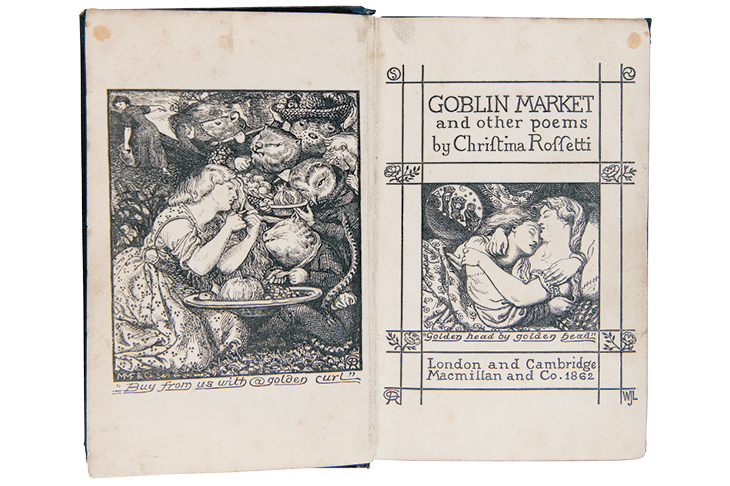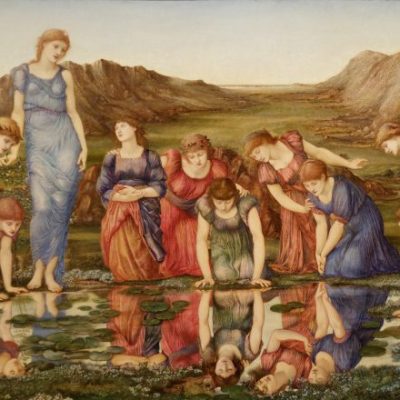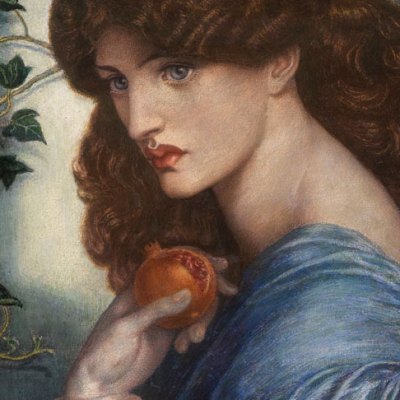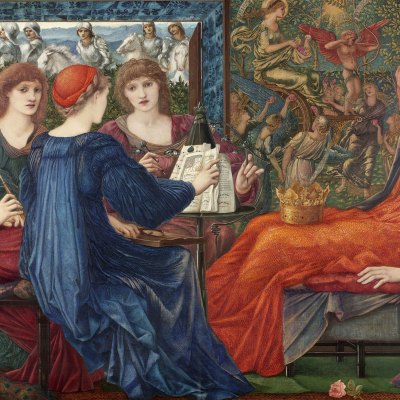 The walls of the drawing room at 30 Torrington Square, the house in which Christina Rossetti (1830–94) spent the final years of her life, were filled with family portraits. They included pictures of her brother Dante Gabriel, co-founder of the Pre-Raphaelite Brotherhood, and of her maternal uncle John Polidori, Byron’s physician in 1816 and the author of The Vampyre. Many were by Gabriel’s own hand, including one of Rossetti herself. Flowingly executed in coloured chalks in 1866, it shows her at half-length, looking up from a desk and an open book, a studious version of the kind of enchanted beauty Gabriel liked to paint throughout his life. Her second collection of poems had just been published and Gabriel had photographs of the portrait taken so that she could send them to friends. ‘Please accept the unworthy little phiz as the phiz of a friend,’ she wrote to one with typical self-effacement.
The walls of the drawing room at 30 Torrington Square, the house in which Christina Rossetti (1830–94) spent the final years of her life, were filled with family portraits. They included pictures of her brother Dante Gabriel, co-founder of the Pre-Raphaelite Brotherhood, and of her maternal uncle John Polidori, Byron’s physician in 1816 and the author of The Vampyre. Many were by Gabriel’s own hand, including one of Rossetti herself. Flowingly executed in coloured chalks in 1866, it shows her at half-length, looking up from a desk and an open book, a studious version of the kind of enchanted beauty Gabriel liked to paint throughout his life. Her second collection of poems had just been published and Gabriel had photographs of the portrait taken so that she could send them to friends. ‘Please accept the unworthy little phiz as the phiz of a friend,’ she wrote to one with typical self-effacement.
Portrait of Christina Rossetti (1877), Dante Gabriel Rossetti
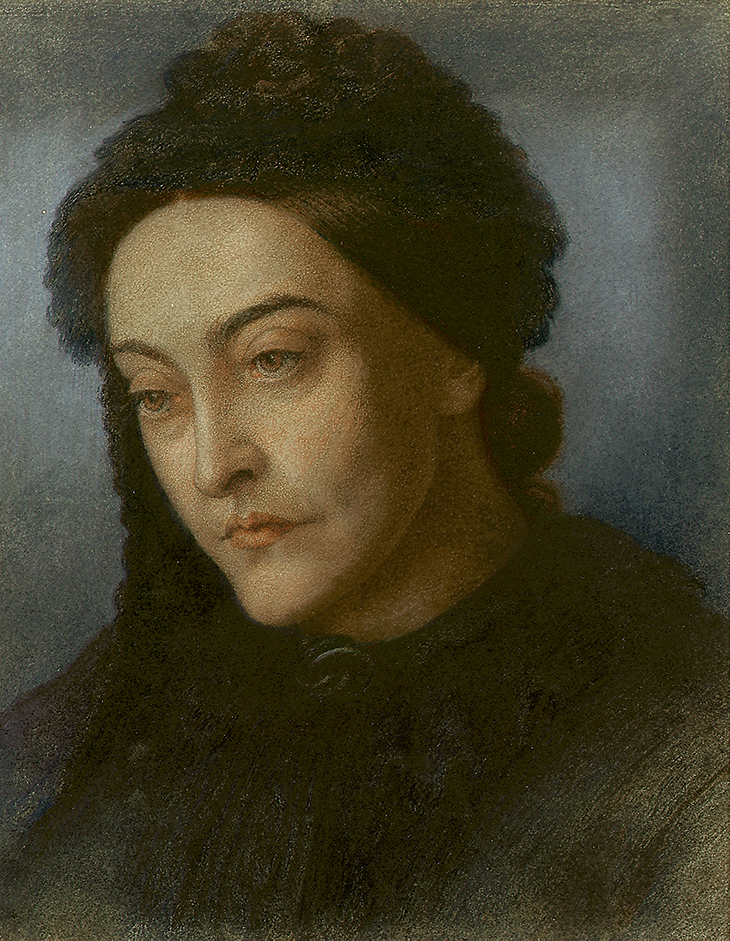
‘Rarely, if ever, has a major poet grown up so deeply embedded in an avant-garde visual culture,’ writes Nicholas Tromans in Christina Rossetti: Poetry in Art, a collection of five essays exploring different aspects of Rossetti’s relationship to art. Her other brother, William, was the PRB’s amanuensis and unofficial spokesman. She contributed poems to its short-lived journal, The Germ, and modelled for a number of paintings, her features arguably contributing to what became the standard Pre-Raphaelite representation of women. But her private attitude to art was, like everything in her life, deeply shaped by her faith. After the mysterious breakdown she suffered in her teens, described by one doctor as ‘religious mania’, she went from being a lively girl to a pious and solemn young woman who abhorred anything that smacked of vanity. In this she was heavily influenced by the Tractarians, with their doctrine of reserve, according to which divine truth was encoded in the visible world to be deciphered only by the faithful. The Pre-Raphaelite emphasis on truth to nature was for her misguided; if art succeeded at all, it was by being symbolic, not naturalistic or beautiful. Tellingly, the picture she liked most for its own sake in the Torrington Square drawing room was not one of Gabriel’s works but a cheap reproduction of Frederick Shields’ The Good Shepherd, a syrupy portrayal of Christ among his flock. Her first biographer reported that her couch was usually placed so that she could see the image clearly.
What is surprising about Rossetti is that for someone who loathed ‘display’ she appears in a large number of images. Susan Owens’ excellent chapter traces Rossetti’s appearance in art and photographs over the course of her life. The photographs, most memorably those taken by Charles Dodgson (Lewis Carroll) in 1863, document her looks fairly matter-of-factly from her middle years onwards. The art provides a more enigmatic record. She appears different in almost every image; perhaps her shyness led others to impose their own visions on to her. Gabriel endlessly made portraits of his sister, from early sketches and his first completed oil painting in 1848 to a group of sepulchral chalk drawings in 1877, when he was recovering from a breakdown. She was also painted in 1848 by James Collinson, an original member of the PRB to whom she was engaged until he reconverted to Catholicism in 1850 (his half-heartedness perhaps signalled by how dreary he makes her look), and in 1857 by John Brett, a landscape specialist on the fringes of the Pre-Raphaelite circle. She may have been romantically involved with Brett, too, but biographical information is scant. William wrote that Brett was ‘smitten’ with her. Was it about him that she wrote ‘No, thank you, John’, a droll poem of 1860 in which the narrator rebukes an insistent lover? Brett’s exquisite, idealised portrait (reproduced on the cover of the book) was left unfinished, perhaps as a result of the end of their intimacy.
Portrait of Christina and Frances Rossetti (1863), Charles Lutwidge Dodgson (Lewis Carroll), University of Delaware Library

The broadest challenge here is taken up by Tromans – who, with Owens, edited the book – in a rich chapter on Rossetti’s attitudes to art. Tromans suggests that she actively kept the visual arts at arm’s length as a reaction to having grown up in such proximity to them, given her need to maintain her own imaginative space. Indeed one constantly wonders at the effect on her personality of being raised alongside the extroverted Gabriel. Yet her art does have a connection to the Pre-Raphaelites, he argues, in the way her poetic voice echoes ‘the Pre-Raphaelite urge to recover a medieval spirituality, lyrical but severely unworldly’. Edmund Gosse called this her ‘brilliant simplicity’, which he compared to early Italian painting.
In achieving that simplicity, Rossetti’s poetry has an emotional mutability that the Pre-Raphaelites’ work could never be said to possess. Of all her poems, few have invited as many varying interpretations as ‘Goblin Market’, her deliciously earthy story of two sisters encountering the perils of sensual temptation. It was originally titled ‘A Peep at the Goblins’ until Gabriel suggested changing it. ‘Always keen to promote his sister’s work,’ writes Stephen Calloway in a fascinating essay on Rossetti and the art of the book, her brother not only helped her gather, shape and select the poems that went into Goblin Market and Other Poems, her first collection, in 1862, but he also created winning illustrations for the book’s title page and frontispiece, and designed its binding. Calloway’s discussion of this subject is one of the highlights here. Other memorable illustrations of ‘Goblin Market’ include the famous 20th-century designs by Florence Harrison and Arthur Rackham, the work of the latter being parodied by Kinuko Craft in 1973 for a set of lightly pornographic illustrations that appeared in Playboy magazine.
Frontispiece illustration to Christina Rossetti, Goblin Market (1933), Arthur Rackham
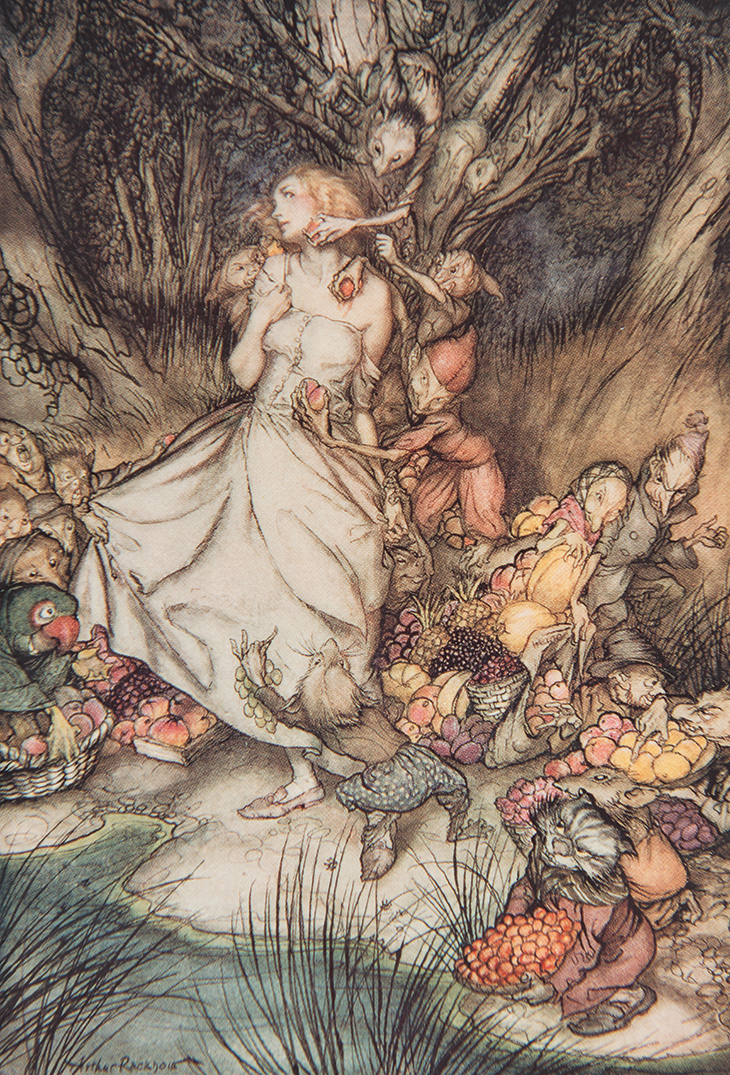
Many of these books and illustrations, and a number of other images inspired by Rossetti’s poetry, are on view at the Watts Gallery, Surrey, in the small but lively exhibition from which this volume grew (until 17 March). The Brett portrait is the jewel of the show, but two enjoyably melodramatic paintings by John Byam Shaw, who made a whole series of pictures based on Rossetti’s poems, are also worth seeking out (one of them is not in the book).
Further essays include a nuanced exploration of Rossetti’s illustrations to her own and others’ books and a broad concluding chapter on the way artists have responded to her poetry over the years. The volume is abundantly illustrated and provides a satisfying contribution to the study of an immensely complex poet and an aspect of 19th-century art with which she is unavoidably intertwined. ‘I am afraid you find art interfere[s] with the legitimate exercise of anguish,’ Gabriel wrote to his sister in 1853. You come away from this book feeling that the comment was both perceptive and barely half the story.
Christina Rossetti: Poetry in Art by Susan Owens and Nicholas Tromans (eds.) is published by Yale University Press.
From the January 2019 issue of Apollo. Preview and subscribe here.
